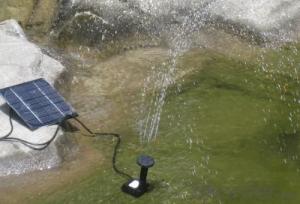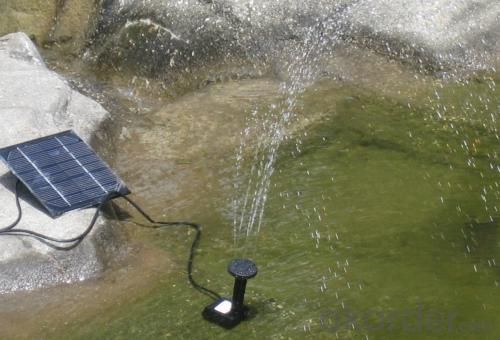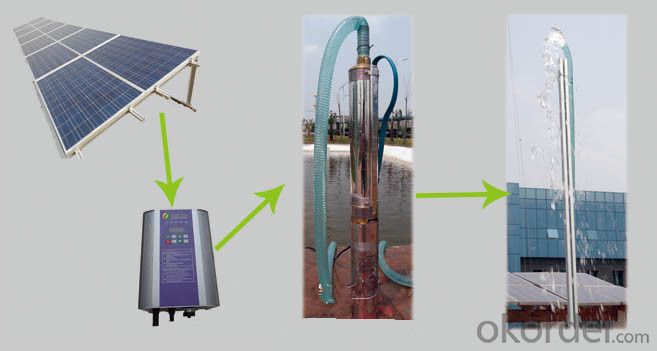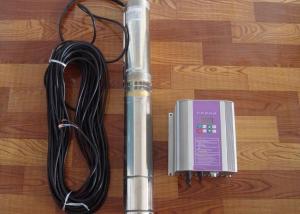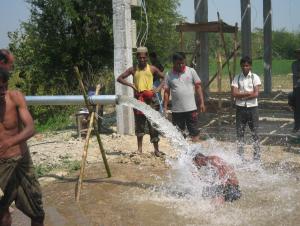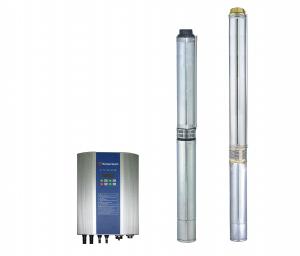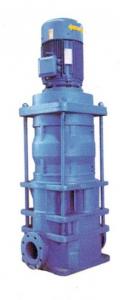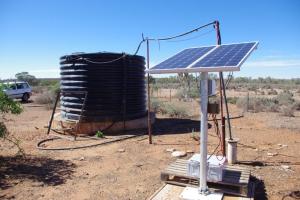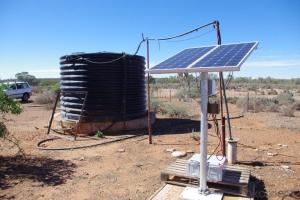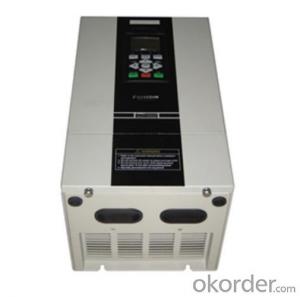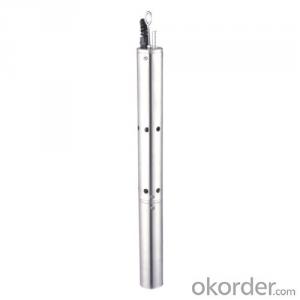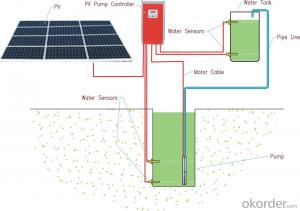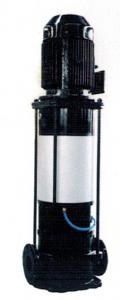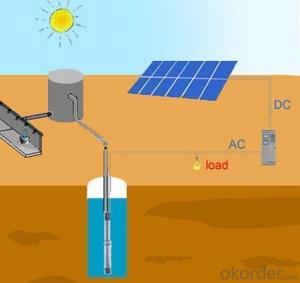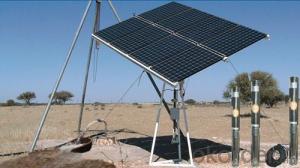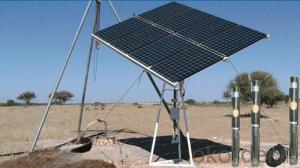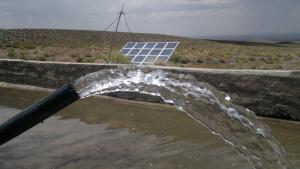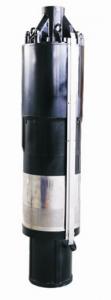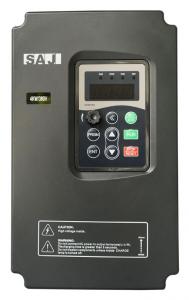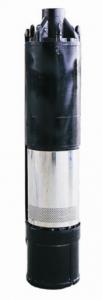Solar Pump Manufacturer's Solar Bore Pumps Solar Water Pump Price List
- Loading Port:
- Shanghai
- Payment Terms:
- TT OR LC
- Min Order Qty:
- 1 set
- Supply Capability:
- 1000 set/month
OKorder Service Pledge
OKorder Financial Service
You Might Also Like
Solar Bore Pumps Solar Water Pump Price List
DC solar water pumping system consists of the motor, pump, controller, solar array and some other accessories, such as water level sensor, float switch, etc. Considered that storing water is more efficient than storing electricity, the system is designed to directly drive the pump without battery which can reduce the construction and operating cost and routine maintenance effectively.The PV array consists of multiple solar panels connected in series/parallel, which can supply the whole system as power source by converting the absorbed solar radiation energy to the electrical energy. The pump driven by a brushless DC permanent magnet motor draws water from deep-well or river. The pumped water is then fed into reservoir or water tank, or connected to the irrigation system or fountain system directly.
Advanced Technology
Applications Innovation
The efficiency of DC brushless permanent magnet motor has been increased up to 25% in comparison with traditional asynchronous motor.
Technology Innovation
Stator and rotor are sealed by environment friendly casting resin.Motor insulation resistance can be hold higher than 300MΩfor more than 10 years, which consumedly increased the security and reliability of the submersible motor.
Structure Innovation
Casting resign technology processed stator and rotor as well as the water lubricated bearing make the submersible pump environment friendly.
Feature
High Efficiency & High Reliability
DC Brushless Permanent Magnet Motor
Minimum Maintenance, long Service Life
Environment Friendly Materials, Lubricated Without Oil
Application
Village or Family Water Supply
Animal Drinking Water & Livestock Watering
Garden/Courtyard Irrigation
Swimming Pool
Water Supply for Bivouac or Camping Car
Water Supply for Remote Area
Automatic Control
Operate Automatically, No Need Watching
Maximum Power Point Tracking (MPPT)
Dry-run Protection
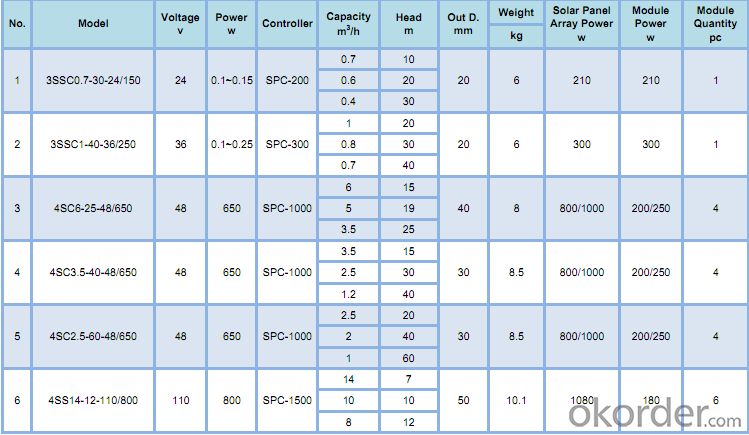
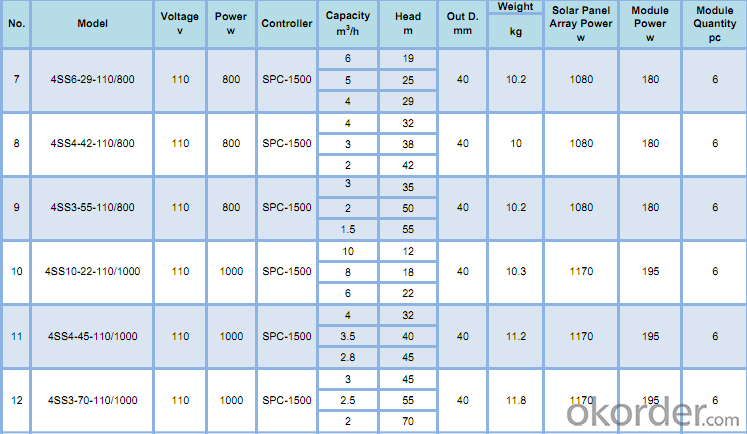
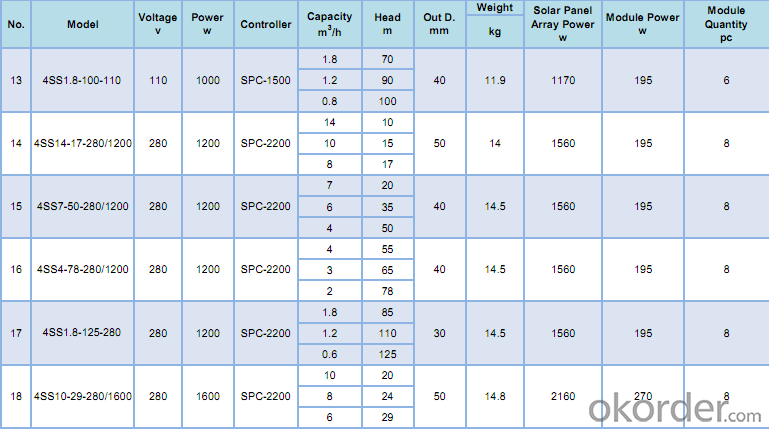
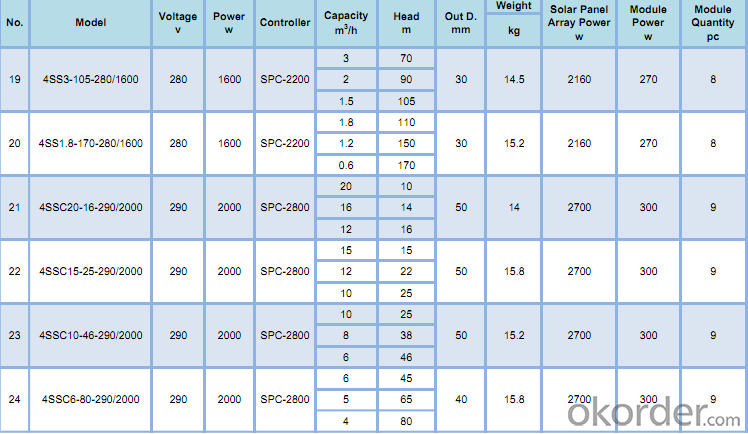


- Q: Can a solar pump be used for water supply in off-grid dairy farms?
- Yes, a solar pump can be used for water supply in off-grid dairy farms. Solar pumps are an excellent option for off-grid applications as they operate using solar energy, eliminating the need for grid electricity. These pumps use photovoltaic (PV) panels to convert sunlight into electricity, which powers the pump to move water from a source to the desired location. For dairy farms located in remote areas without access to the grid, solar pumps offer a reliable and sustainable solution for water supply. They can be used to draw water from wells, boreholes, or other water sources and distribute it to various areas of the farm, such as livestock watering troughs, cleaning systems, or irrigation systems. Solar pumps have several advantages for off-grid dairy farms. Firstly, they are cost-effective in the long run as they don't require any electricity bills or fuel costs. Additionally, they have minimal maintenance requirements, reducing operational costs. Furthermore, solar pumps are environmentally friendly, as they produce clean energy and do not contribute to greenhouse gas emissions. It's important to note that the size and capacity of the solar pump should be chosen according to the specific water requirements of the dairy farm. Factors such as the number of livestock, daily water consumption, and distance to the water source should be considered when selecting an appropriate solar pump system. Overall, solar pumps are a viable and efficient option for water supply in off-grid dairy farms, providing a reliable and sustainable solution for meeting the water needs of the farm while reducing costs and environmental impact.
- Q: Can a solar pump be used for heating water?
- Yes, a solar pump can be used for heating water. Solar pumps are commonly used in solar water heating systems to circulate water from storage tanks or collectors to the desired location, such as showers or faucets. The sun's energy is used to heat the water, and the solar pump helps in circulating the water through the system, ensuring efficient heat transfer. This type of system is environmentally friendly and can significantly reduce energy costs associated with heating water.
- Q: Can a solar pump be used for water supply in off-grid schools?
- Yes, a solar pump can be used for water supply in off-grid schools. Solar pumps are an excellent option for off-grid locations, as they rely on solar energy to power the pump, eliminating the need for grid electricity. This makes them a sustainable and cost-effective solution for water supply in areas where electricity is not readily available. Solar pumps can be used to extract water from wells, boreholes, or other water sources, and they can deliver water to storage tanks or directly to the school's water distribution system. They are particularly suitable for off-grid schools as they can operate independently without the need for complex and expensive infrastructure. Solar pumps are also environmentally friendly, as they do not require any fuel or produce any greenhouse gas emissions during operation. They are low-maintenance and have a long lifespan, making them a reliable and sustainable solution for water supply in off-grid schools. Furthermore, solar pumps can be equipped with battery storage systems, allowing them to operate even during cloudy days or at night. This ensures a continuous water supply to the school, regardless of weather conditions or time of day. In conclusion, solar pumps are a viable and efficient option for water supply in off-grid schools. They offer a sustainable, cost-effective, and reliable solution, ensuring access to clean water for students and staff in remote areas.
- Q: Are solar pumps suitable for use in mountainous regions with varying elevation?
- Yes, solar pumps are suitable for use in mountainous regions with varying elevation. Solar pumps are versatile and can be installed in different terrains, including mountainous areas. They are powered by solar energy, making them independent of electricity grids, which is particularly advantageous in remote regions. Additionally, solar pumps can adjust their pumping capacity based on the available sunlight, making them adaptable to the varying elevation and sunlight conditions of mountainous regions.
- Q: What is the impact of a solar pump on wildlife conservation?
- A solar pump has a positive impact on wildlife conservation as it provides a sustainable and clean source of water for both wildlife and their habitats. By reducing the dependence on traditional energy sources, solar pumps help to minimize habitat destruction and pollution associated with fossil fuel extraction and usage. Additionally, the availability of water from solar pumps ensures that wildlife populations have access to vital resources, promoting their overall well-being and contributing to the preservation of biodiversity.
- Q: Are there any limitations to the depth of water a solar pump can lift?
- There are indeed limitations to the depth at which a solar pump can lift water. The maximum depth that a solar pump can lift water is determined by various factors, including the power and efficiency of the solar panels, the size and capacity of the pump, and the distance between the pump and the water source. Usually, solar pumps are designed to lift water from depths ranging from 20 to 200 feet. Nevertheless, as the depth increases, the power required to lift the water also increases. Solar panels have a limited capacity to generate power, especially in low-light conditions or on cloudy days, which can affect the pump's performance. Moreover, the efficiency of the pump itself may decrease as the depth increases, as it must work harder against gravity to lift the water. In the case of extremely deep water sources, it may be necessary to utilize specialized solar pumps or combine solar power with other energy sources like batteries or generators to overcome these limitations. To determine the appropriate solar pump for specific depth requirements, it is advisable to consult with a professional or the pump's manufacturer.
- Q: Can a solar pump be used in areas with strict building codes or regulations?
- Yes, a solar pump can be used in areas with strict building codes or regulations. Solar pumps are typically compact, self-contained units that do not require extensive construction or infrastructure. They can be easily installed without the need for extensive building permits or complex installations. Additionally, solar pumps are environmentally friendly and energy efficient, making them a suitable choice for areas with strict regulations on energy consumption and environmental impact.
- Q: How does the availability of sunlight affect the performance of a solar pump?
- The performance of a solar pump is directly impacted by the amount of sunlight available. Solar pumps rely on solar panels to convert sunlight into electricity, which then powers the pump. Therefore, the efficiency and productivity of the pump are determined by the quantity and intensity of sunlight. In regions where sunlight is abundant, the availability of sunlight ensures that the solar panels receive an optimal amount of energy to generate electricity. This leads to higher pump performance as more energy is available to power the pump, resulting in increased water flow rates and pumping capacity. On the other hand, in areas with limited sunlight or frequent cloudy weather, the performance of a solar pump may be negatively affected. The reduced availability of sunlight decreases the amount of energy produced by the solar panels, leading to lower pump performance. This can result in reduced water flow rates, decreased pumping capacity, and potentially inadequate water supply for irrigation, livestock, or other applications. It is important to note that solar pumps often have built-in mechanisms to cope with variations in sunlight availability. They may include energy storage systems, such as batteries, to store excess energy during sunny periods and utilize it during periods of low sunlight. This helps to maintain a more consistent and reliable pump performance even when sunlight is less available. In summary, the availability of sunlight is crucial in determining the performance of a solar pump. Regions with high solar irradiance generally benefit from more efficient and productive solar pumps, while areas with lower sunlight availability may experience reduced pump performance.
- Q: Can a solar pump be used in remote areas?
- Yes, a solar pump can be used in remote areas. Solar pumps are powered by sunlight, making them ideal for locations that are not connected to the traditional power grid. They can provide a reliable and sustainable source of water supply in remote areas, reducing the dependency on fuel-based generators or long power transmission lines. Additionally, solar pumps require minimal maintenance and have a long lifespan, making them a cost-effective solution for remote communities.
- Q: Can a solar pump be used for water supply in remote villages?
- Yes, a solar pump can be used for water supply in remote villages. Solar pumps are a sustainable and cost-effective solution for providing water in areas where there is no access to electricity. They rely on solar energy to power the pump, which means they can operate independently and reliably in remote locations. Additionally, solar pumps require minimal maintenance and have a long lifespan, making them suitable for sustainable water supply in remote villages.
Send your message to us
Solar Pump Manufacturer's Solar Bore Pumps Solar Water Pump Price List
- Loading Port:
- Shanghai
- Payment Terms:
- TT OR LC
- Min Order Qty:
- 1 set
- Supply Capability:
- 1000 set/month
OKorder Service Pledge
OKorder Financial Service
Similar products
Hot products
Hot Searches
Related keywords
